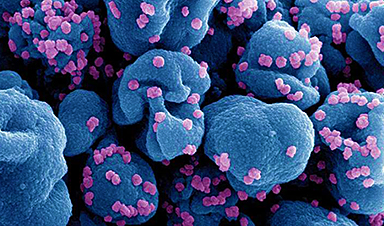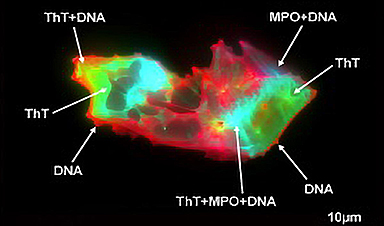Light can behave in very unexpected ways when you squeeze it into small spaces. In a paper in the journal Science, Mark Brongersma, a professor of materials science and engineering at Stanford University, and doctoral candidate Skyler Selvin describe the novel way they have used sound to manipulate light that has been confined to gaps only a few nanometers across—allowing the researchers exquisite control over the color and intensity of light mechanically.
The findings could have broad implications in fields ranging from computer and virtual reality displays to 3D holographic imagery, optical communications, and even new ultrafast, light-based neural networks.
The new device is not the first to manipulate light with sound, but it is smaller and potentially more practical and powerful than conventional methods. From an engineering standpoint, acoustic waves are attractive because they can vibrate very fast, billions of times per second.
Unfortunately, the atomic displacements produced by acoustic waves are extremely small—about 1,000 times smaller than the wavelength of light. Thus, acousto‑optical devices have had to be larger and thicker to amplify sound’s tiny effect—too big for today’s nanoscale world.
“In optics, big equals slow,” Brongersma said. “So, this device’s small scale makes it very fast.”
Simplicity from the start
The new device is deceptively simple. A thin gold mirror is coated with an ultrathin layer of a rubbery silicone‑based polymer only a few nanometers thick. The research team could fabricate the silicone layer to desired thicknesses—anywhere between 2 and 10 nanometers. For comparison, the wavelength of light is almost 500 nanometers tip to tail.
The researchers then deposit an array of 100‑nanometer gold nanoparticles across the silicone. The nanoparticles float like golden beach balls on an ocean of polymer atop a mirrored sea floor. Light is gathered by the nanoparticles and mirror and focused onto the silicone between—shrinking the light to the nanoscale.
To the side, they attach a special kind of ultrasound speaker—an interdigitated transducer, IDT—that sends high‑frequency sound waves rippling across the film at nearly a billion times a second. The high‑frequency sound waves (surface acoustic waves, SAWs) surf along the surface of the gold mirror beneath the nanoparticles. The elastic polymer acts like a spring, stretching and compressing as the nanoparticles bob up and down as the sound waves course by.
The researchers then shine light into the system. The light gets squeezed into the oscillating gaps between the gold nanoparticles and the gold film. The gaps change in size by the mere width of a few atoms, but it is enough to produce an outsized effect on the light.
The size of the gaps determines the color of the light resonating from each nanoparticle. The researchers can control the gaps by modulating the acoustic wave and therefore control the color and intensity of each particle.
“In this narrow gap, the light is squeezed so tightly that even the smallest movement significantly affects it,” Selvin said. “We are controlling the light with lengths on the nanometer scale, where typically millimeters have been required to modulate light acoustically.”
Starry, starry sky
When white light is shined from the side and the sound wave is turned on, the result is a series of flickering, multicolored nanoparticles against a black background, like stars twinkling in the night sky. Any light that does not strike a nanoparticle is bounced out of the field of view by the mirror, and only the light that is scattered by the particles is directed outward toward the human eye. Thus, the gold mirror appears black and each gold nanoparticle shines like a star.
The degree of optical modulation caught the researchers off guard. “I was rolling on the floor laughing,” Brongersma said of his reaction when Selvin showed him the results of his first experiments.
“I thought it would be a very subtle effect, but I was amazed at how many nanometer changes in distance can change the light scattering properties so dramatically.”
The exceptional tunability, small form factor, and efficiency of the new device could transform any number of commercial fields. One can imagine ultrathin video displays, ultra‑fast optical communications based on acousto‑optics’ high‑frequency capabilities, or perhaps new holographic virtual reality headsets that are much smaller than the bulky displays of today, among other applications.
“When we can control the light so effectively and dynamically,” Brongersma said, “we can do everything with light that we could want—holography, beam steering, 3D displays—anything.”
More information: Skyler Peitso Selvin et al, Acoustic wave modulation of gap plasmon cavities, Science (2025). DOI: 10.1126/science.adv1728. www.science.org/doi/10.1126/science.adv1728
Journal information: Science
Provided by Stanford University
News
Fever-Proof Bird Flu Variant Could Fuel the Next Pandemic
Bird flu viruses present a significant risk to humans because they can continue replicating at temperatures higher than a typical fever. Fever is one of the body’s main tools for slowing or stopping viral [...]
What could the future of nanoscience look like?
Society has a lot to thank for nanoscience. From improved health monitoring to reducing the size of electronics, scientists’ ability to delve deeper and better understand chemistry at the nanoscale has opened up numerous [...]
Scientists Melt Cancer’s Hidden “Power Hubs” and Stop Tumor Growth
Researchers discovered that in a rare kidney cancer, RNA builds droplet-like hubs that act as growth control centers inside tumor cells. By engineering a molecular switch to dissolve these hubs, they were able to halt cancer [...]
Platelet-inspired nanoparticles could improve treatment of inflammatory diseases
Scientists have developed platelet-inspired nanoparticles that deliver anti-inflammatory drugs directly to brain-computer interface implants, doubling their effectiveness. Scientists have found a way to improve the performance of brain-computer interface (BCI) electrodes by delivering anti-inflammatory drugs directly [...]
After 150 years, a new chapter in cancer therapy is finally beginning
For decades, researchers have been looking for ways to destroy cancer cells in a targeted manner without further weakening the body. But for many patients whose immune system is severely impaired by chemotherapy or radiation, [...]
Older chemical libraries show promise for fighting resistant strains of COVID-19 virus
SARS‑CoV‑2, the virus that causes COVID-19, continues to mutate, with some newer strains becoming less responsive to current antiviral treatments like Paxlovid. Now, University of California San Diego scientists and an international team of [...]
Lower doses of immunotherapy for skin cancer give better results, study suggests
According to a new study, lower doses of approved immunotherapy for malignant melanoma can give better results against tumors, while reducing side effects. This is reported by researchers at Karolinska Institutet in the Journal of the National [...]
Researchers highlight five pathways through which microplastics can harm the brain
Microplastics could be fueling neurodegenerative diseases like Alzheimer's and Parkinson's, with a new study highlighting five ways microplastics can trigger inflammation and damage in the brain. More than 57 million people live with dementia, [...]
Tiny Metal Nanodots Obliterate Cancer Cells While Largely Sparing Healthy Tissue
Scientists have developed tiny metal-oxide particles that push cancer cells past their stress limits while sparing healthy tissue. An international team led by RMIT University has developed tiny particles called nanodots, crafted from a metallic compound, [...]
Gold Nanoclusters Could Supercharge Quantum Computers
Researchers found that gold “super atoms” can behave like the atoms in top-tier quantum systems—only far easier to scale. These tiny clusters can be customized at the molecular level, offering a powerful, tunable foundation [...]
A single shot of HPV vaccine may be enough to fight cervical cancer, study finds
WASHINGTON -- A single HPV vaccination appears just as effective as two doses at preventing the viral infection that causes cervical cancer, researchers reported Wednesday. HPV, or human papillomavirus, is very common and spread [...]
New technique overcomes technological barrier in 3D brain imaging
Scientists at the Swiss Light Source SLS have succeeded in mapping a piece of brain tissue in 3D at unprecedented resolution using X-rays, non-destructively. The breakthrough overcomes a long-standing technological barrier that had limited [...]
Scientists Uncover Hidden Blood Pattern in Long COVID
Researchers found persistent microclot and NET structures in Long COVID blood that may explain long-lasting symptoms. Researchers examining Long COVID have identified a structural connection between circulating microclots and neutrophil extracellular traps (NETs). The [...]
This Cellular Trick Helps Cancer Spread, but Could Also Stop It
Groups of normal cbiells can sense far into their surroundings, helping explain cancer cell migration. Understanding this ability could lead to new ways to limit tumor spread. The tale of the princess and the [...]
New mRNA therapy targets drug-resistant pneumonia
Bacteria that multiply on surfaces are a major headache in health care when they gain a foothold on, for example, implants or in catheters. Researchers at Chalmers University of Technology in Sweden have found [...]
Current Heart Health Guidelines Are Failing To Catch a Deadly Genetic Killer
New research reveals that standard screening misses most people with a common inherited cholesterol disorder. A Mayo Clinic study reports that current genetic screening guidelines overlook most people who have familial hypercholesterolemia, an inherited disorder that [...]





















